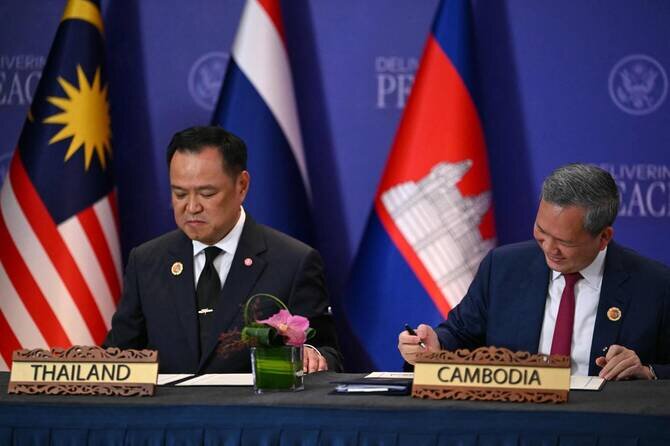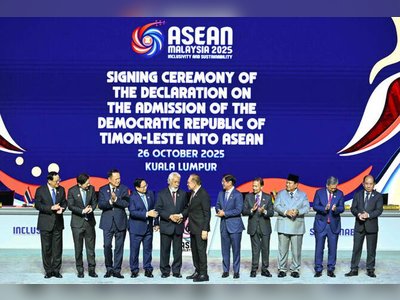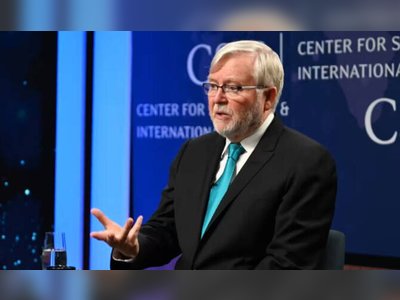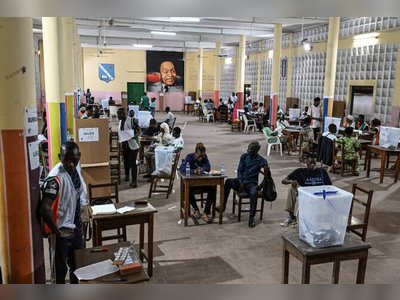
Thailand and Cambodia Expand Ceasefire Agreement Following July Border Conflict
The expansion of the ceasefire, brokered by US President Donald Trump, aims to further mitigate hostilities between Thailand and Cambodia.
KUALA LUMPUR: In a significant diplomatic move, Cambodia and Thailand have formally signed an expanded ceasefire agreement.
This development follows the recent border conflict in July, which was ultimately resolved with assistance from United States President Donald Trump.
The conflict, marked by intense fighting and resulting in numerous casualties, had also displaced hundreds of thousands of people.The expanded ceasefire signing occurred during the annual summit of the Association of Southeast Asian Nations (ASEAN), a regional organization to which both countries belong.
Witnessing the signing were Cambodian Prime Minister Hun Manet and Thai Prime Minister Anutin Charnvirakul, alongside international dignitaries and ASEAN leaders.A key component of this expanded agreement involves Thailand's release of 18 Cambodian soldiers who had been held as prisoners since the conflict escalated.
Additionally, both countries have committed to the removal of heavy weaponry from their shared border area, a move aimed at significantly reducing tensions along the 800-kilometer frontier that has long been a source of dispute between them.The longstanding territorial disputes between Thailand and Cambodia, which date back several decades, had previously led to isolated and brief skirmishes.
However, the recent conflict raised concerns on an international level due to its severity and the extensive humanitarian impact it posed.
The involvement of US President Donald Trump, who utilized trade tariffs as leverage to facilitate negotiations, underscores the global dimensions of this regional issue.The expanded ceasefire represents a concerted effort by ASEAN member states to foster peace and stability within the region.
This agreement stands as a testament to the potential for diplomatic solutions in resolving complex territorial disputes, particularly when supported by influential international actors.
This development follows the recent border conflict in July, which was ultimately resolved with assistance from United States President Donald Trump.
The conflict, marked by intense fighting and resulting in numerous casualties, had also displaced hundreds of thousands of people.The expanded ceasefire signing occurred during the annual summit of the Association of Southeast Asian Nations (ASEAN), a regional organization to which both countries belong.
Witnessing the signing were Cambodian Prime Minister Hun Manet and Thai Prime Minister Anutin Charnvirakul, alongside international dignitaries and ASEAN leaders.A key component of this expanded agreement involves Thailand's release of 18 Cambodian soldiers who had been held as prisoners since the conflict escalated.
Additionally, both countries have committed to the removal of heavy weaponry from their shared border area, a move aimed at significantly reducing tensions along the 800-kilometer frontier that has long been a source of dispute between them.The longstanding territorial disputes between Thailand and Cambodia, which date back several decades, had previously led to isolated and brief skirmishes.
However, the recent conflict raised concerns on an international level due to its severity and the extensive humanitarian impact it posed.
The involvement of US President Donald Trump, who utilized trade tariffs as leverage to facilitate negotiations, underscores the global dimensions of this regional issue.The expanded ceasefire represents a concerted effort by ASEAN member states to foster peace and stability within the region.
This agreement stands as a testament to the potential for diplomatic solutions in resolving complex territorial disputes, particularly when supported by influential international actors.










